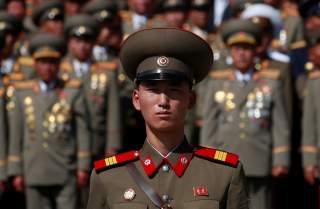The Second Coming of Kim Jong Un
Will 2019 and 2020 become the years of peaceful transformation? Or should Washington prepare for a phony political peace?
The leaders of the United States and North Korea waited seventy years to have a first face-to-face encounter. That happened on June 12, when Chairman Kim Jong-un met President Donald Trump in Singapore. Now the pair is preparing for an encore encounter, which will mark the second summit in about four months.
The first coming of Kim brought the United States full circle from last year’s “maximum pressure” and “fire and fury;” the second coming of Chairman Kim is apt to go further, solidifying an end-of-war declaration as a quid pro quo for the beginning of verifiable denuclearization steps. Peace and denuclearization are the two tracks of North Korean diplomacy that must run in tandem, each depending on the other to maintain momentum, and both tracks exposing the U.S.-South Korean alliance—and North Korea—to new risks and vulnerabilities.
While appreciating Kim’s savvy diplomacy this past year, South Korean president Moon Jae-in is the essential choreographer of this diplomatic dance.
On Monday afternoon at the United Nations in New York, Moon briefed Trump on what specific steps Kim said he is willing to take toward dismantling nuclear and missile programs. He went beyond the public disclosure of possibly permanently closing the Yongbyon nuclear facility, something often negotiated in the past and which most analysts believe is no longer the only or main facility for producing weapons-grade nuclear fuel.
Moon also apprised Trump on what “corresponding measures” Kim expects in return for expediting denuclearization. Although the world knew that skeletal outline of a plan after Moon’s visit to Pyongyang last week, the South Korean president held onto the detailed information until he could brief Trump himself in the hope of persuading the U.S. president to return to the summit with Kim and embrace the politically controversial move of an end-of-war declaration as the minimum price for commencing denuclearization.
The Pyongyang declaration between Moon and Kim surprisingly breathed new life into diplomacy with North Korea. After all, three months after the historic Kim-Trump summit in Singapore, including a prematurely announced end of the nuclear threat, North Korea had increased rather than decreased its nuclear arsenal. Kim had halted nuclear and missile testing—perhaps persuaded that circumspection was better than brinkmanship—but by all accounts, North Korea had not slowed down the production of nuclear material, weapons, or missiles.
To take the next step and go from a nuclear and missile testing freeze to a verifiable halt to the production of enriched uranium and the safeguarding and eventual elimination of weapons-grade fissile material, North Korea wants airtight security guarantees in the form of a political commitment announcing the end of war and the beginning of a process to replace the 1953 Armistice with a peace treaty. While this will only be a political statement, it will erode the readiness and strength of the U.S.-ROK military alliance, much in the same way summit diplomacy has reduced maximum-pressure sanctions to perhaps 80 percent strength and declining.
Regarding the North Korea problem, 2018 remains the year of experimental diplomacy.
Having gone half way to test the intentions of Chairman Kim, there is no way to halt the momentum now without ruining what could be a unique window of opportunity. By the end of this year, we will have fully tested whether the third-generation Kim family regime is willing to make serious concessions on nuclear weapons to move towards a cessation of a long-running cold war. However, we still won’t know whether Kim intends to implement those concessions on a timetable compatible with the needs of democratically elected governments. This means that 2019 and 2020 could either become the years of peaceful transformation or a phony political peace that will reveal itself to lack substance and sustainability over time.
Thus far, the steps Kim has taken or might take next month are still consistent with want to achieve his goals without making major sacrifices. That is, Kim wants to block potential regime-change military attacks, bust the sanctions and pressures arrayed against North Korea, and turn on international flows of investment into Pyongyang—and achieve all of this without giving up nuclear-armed missiles.
Even so, the steps thus far—and that could be taken at a second Trump-Kim summit—would bring the world closer to ending the cold war on the Korean Peninsula than any time since the outbreak of war. It remains a diplomatic experiment worth attempting, albeit carefully, deliberately, step by step, and with due diligence and verification.
Dr. Patrick M. Cronin is senior director of the Asia-Pacific Security Program at the Center for a New American Security in Washington, DC.

